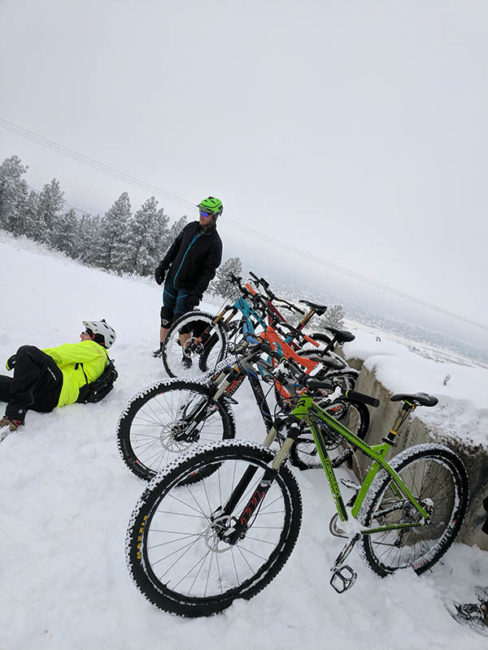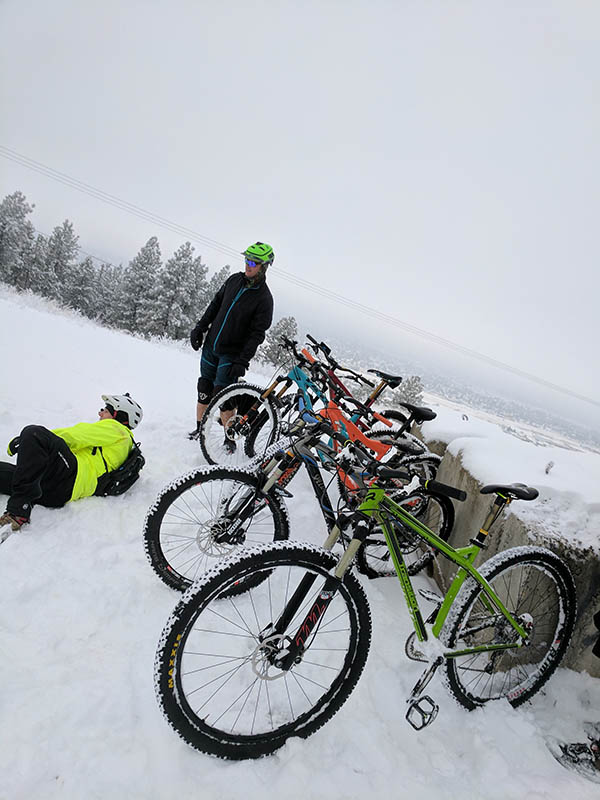Despite what you may think, it is quite possible to ride bikes in the winter months and you don’t need a fat bike!
Yes it is a lot more work, but it is a lot of fun and it will improve your skills come spring.
 Here are a few tips to get you started;
Here are a few tips to get you started;
- Ditch the clip-less pedals– large platforms are a must. A good grippy shoe is nice, try to find one that strikes the balance of grip on your pedals and grip hiking in the snow (there will be areas you have to hike-a-bike). Easily being able to put your foot down is key to providing balance or prevent from falling in the snow.
- Drop your air pressure- Recommending a 2.2 or larger tire size, you don’t have to have a plus or fat bike to have fun, obviously those applications are going to provide more grip and possibly more fun. I had a blast on my 2.35 Hans Dampf tires at 20lbs of pressure. You may be able to do less pressure, experiment and find what you like, bring a pump.
- Put a mud guard on it- Put a mud guard on your fork and rear triangle, **only do this if you have the frame clearance for it, if you are tight in areas between your frame and tire, the snow will build up and slow you down, ditch the mud guards if this is the case. (local bike shop will have these)
- Dress appropriately- Do not over-dress you would be surprised how fast you warm up, wear a pack so that you can shed a layer if necessary. Bring goggles or over-sized glasses to cover your eyes from wind burn, also bring a thin head band or full face layer to warm up your head, ears, and face.
- Know your body- If you know your hands or feet get especially cold, address those area specifically. This may mean a thicker glove or sock. Factor in the added cold of snow melting on your shoes or gloves, waterproof as much as you can. Waterproof socks are pretty amazing.
- Know what to expect- You aren’t going to be able to shred like you normally do, be ok with it… falling in the snow hurts a lot less and added layers help to protect you. Stick with it and your balance will get better, you will learn to adapt to the conditions and visualize areas where you might slide out or lose grip.
- Harness your skills- Try keeping your weight on the back tire, this is where most of your grip is going to come from especially on the climbs. Don’t fight the terrain, the more you get squirrely on the front end the more like you will go out of control or your bike will slide underneath you. Learn to spot off camber areas and avoid or ride in the middle of a rut. Try experimenting with your suspension, the colder conditions will change how your suspension operates, you may need to add or subtract air pressure.
- Pack well- Make sure you are drinking water, it is easy to forget in the cold weather, but you will be sweating, replace that H2O. Drink consistently so that your water source does not freeze, if it starts to you have not been drinking enough water 🙂 Bring extra snacks in your pack.

